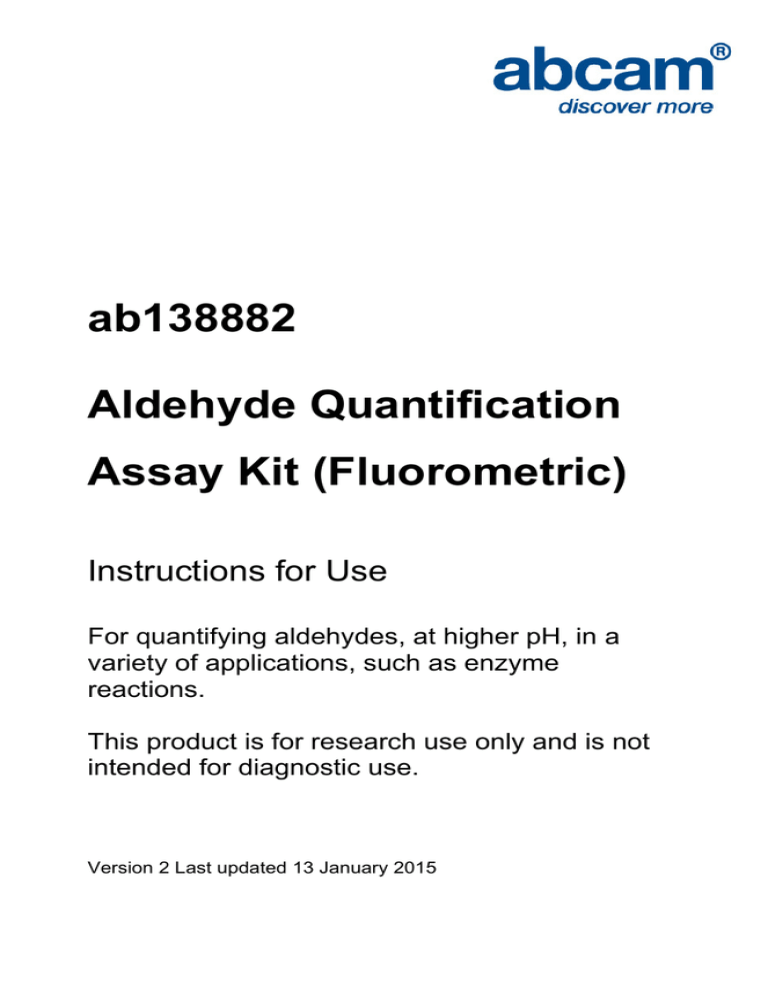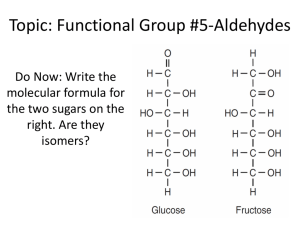
ab138882
Aldehyde Quantification
Assay Kit (Fluorometric)
Instructions for Use
For quantifying aldehydes, at higher pH, in a
variety of applications, such as enzyme
reactions.
This product is for research use only and is not
intended for diagnostic use.
Version 2 Last updated 13 January 2015
1
Table of Contents
1.
Introduction
3
2.
Protocol Summary
5
3.
Kit Contents
6
4.
Storage and Handling
6
5.
Additional Materials Required
7
6.
Assay Protocol
8
7.
Data Analysis
13
8.
Troubleshooting
14
2
1. Introduction
The formation, reactivity and toxicity of aldehydes originating from
the peroxidation of lipids of cellular membranes have received great
attention in recent years. Rapid and accurate measurement of
aldehydes is an important task for biological research, chemical
research, food industry and environmental pollution surveillance.
There are a few reagents or assay kits available for quantifying the
number of aldehydes. Most of the existing aldehyde test methods
are based on separations either by the tedious and expensive
HPLC-MS or GC-MS.
ab138882 is used for quantifying aldehydes at higher pH by using a
proprietary fluorogenic dye that generates a strongly fluorescent
product upon reacting with an aldehyde.
This fluorimetric kit
provides a sensitive mix-and-read method to detect as little as
0.3 nanomole of aldehyde in a 100 µl assay volume (3 µM). The
assay can be performed in a convenient 96-well or 384-well
microtiter-plate format and easily adapted to automation without a
separation step. Its signal can be read by a fluorescence microplate
reader at Ex/Em = 365/435 nm.
3
Kit Key Features
Broad Application: Used for quantifying aldehydes in a
variety of applications, such as enzyme reactions.
Sensitive: Detect as little as 0.3 nanomole of aldehyde in a
100 µl assay volume.
Continuous: Easily adapted to automation without a
separation step.
Convenient: Formulated to have minimal hands-on time.
Non-radioactive:
No
special
requirements
for
waste
treatment.
4
2. Protocol Summary
Summary for One 96-well Plate
Prepare enzyme reaction solution
Add Aldehyde Blue Indicator
Incubate at room temperature for 15 – 30 minutes
Add Aldehyde Reaction Buffer
Monitor fluorescence increase at Ex/Em = 365/435 nm
Note: Thaw all the kit components to room temperature before
starting the experiment.
5
3. Kit Contents
Components
Amount
Aldehyde Blue Indicator
Assay Buffer
Aldehyde Reaction Buffer
1 vial
1 bottle (30 ml)
1 vial (6 ml)
Aldehyde Standard
DMSO
1 vial
1 vial (100 µl)
4. Storage and Handling
Keep at -20°C. Avoid exposure to light.
5. Additional Materials Required
96 or 384-well microplates: Solid black microplates
Fluorescence microplate reader
6
6. Assay Protocol
Note: This protocol is for one 96 - well plate.
A. Preparation of stock solution
1. Preparation of 250X Aldehyde
Blue Indicator stock
solution: Add 40 μl of DMSO in the vial of Aldehyde Blue
Indicator to make Aldehyde
Blue Indicator stock
solution. Note: The unused Aldehyde Blue Indicator
stock solution should be divided into single use aliquots,
and stored at -20 oC.
B. Preparation of Assay Reaction Mixture
1. Preparation of 250X Aldehyde
Blue Indicator assay
reaction mixture: Add 20 μl of 250X Aldehyde
Blue
Indicator stock solution into 5 ml of Assay Buffer and mix
well. Note: 5 ml of Aldehyde Blue Indicator assay
reaction mixture is enough for one plate. The mixture is
not stable and should be used within 2 hours.
7
C. Preparation of Serial Dilutions of Aldehyde Standard (0
to 1 mM)
1. Add 1 ml of Assay Buffer into the vial of Aldehyde
Standard to make 10 mM Aldehyde Standard stock
solution. Note: The unused Aldehyde Standard stock
solution should be divided into single use aliquots, and
stored at -20 oC.
2. Take 100 μl of 10 mM Aldehyde Standard stock solution
to perform 1/10, and 1/3 serial dilutions to get 1000, 300,
100, 30, 10, 3, 1 and 0 μM serial dilutions of Aldehyde
Standard.
3. Add serially diluted aldehyde standards and aldehydecontaining test samples into a solid black 96-well
microplate as described in Tables 1 and 2.
8
Table 1. Layout of Aldehyde Standards and test samples in a solid
black 96-well microplate
BL
BL
AS1
AS1
AS2
AS2
AS3
AS3
AS4
AS4
AS5
AS5
AS6
AS6
AS7
AS7
TS
TS
….
….
Note: AS= Aldehyde Standards, BL=Blank Control, TS=Test Samples.
9
Table 2. Reagent composition for each well
Aldehyde Standard
Blank Control
Test Sample
Serial Dilutions*: 50 μl
Assay Buffer: 50 μl
50 μl
*Note: Add the serially diluted Aldehyde standards from 1 μM to 1000 μM
into wells from AS1 to AS7 in duplicate
10
D. Run Aldehyde Assay:
1. Add 50 µl of Aldehyde Blue Indicator Assay Reaction
Mixture into each well of aldehyde standard, blank
control, and test samples make the total aldehyde assay
volume of 100 µl/well.
Note: For a 384-well plate, add 25 μl of test sample and
25 μl of Aldehyde Blue Indicator Assay Reaction Mixture
into each well.
2. Incubate the Aldehyde Blue Indicator Assay Reaction
Mixture at room temperature for 15-30 minutes,
protected from light.
3. Add 25 μl of Reaction Buffer into each well.
4. Monitor the fluorescence increase at Ex/Em = 365/435
nm using a fluorescence plate reader.
11
7. Data Analysis
The fluorescence in blank wells (0 μM Aldehyde Standard and
Aldehyde Blue Indicator reaction mixture only) is used as a control,
and subtracted from the values of those wells with the aldehyde
reactions.
Figure 1. Aldehyde dose response was measured in a solid black
96-well plate with ab138882 using a fluorescence microplate reader.
As low as 3 µM of aldehyde can be detected with 15 minutes
incubation (n=3). Note: The fluorescence background increases with
time, thus it is important to subtract the fluorescence intensity value
of the blank wells for each data point.
12
8. Troubleshooting
Problem
Reason
Solution
Assay not
working
Assay buffer at
wrong temperature
Assay buffer must not be chilled
- needs to be at RT
Protocol step missed
Plate read at
incorrect wavelength
Unsuitable microtiter
plate for assay
Unexpected
results
Re-read and follow the protocol
exactly
Ensure you are using
appropriate reader and filter
settings (refer to datasheet)
Fluorescence: Black plates
(clear bottoms);
Luminescence: White plates;
Colorimetry: Clear plates.
If critical, datasheet will indicate
whether to use flat- or U-shaped
wells
Measured at wrong
wavelength
Use appropriate reader and filter
settings described in datasheet
Samples contain
impeding substances
Unsuitable sample
type
Sample readings are
outside linear range
Troubleshoot and also consider
deproteinizing samples
Use recommended samples
types as listed on the datasheet
Concentrate/ dilute samples to
be in linear range
13
Problem
Reason
Solution
Samples
with
inconsistent
readings
Unsuitable sample
type
Refer to datasheet for details
about incompatible samples
Use the assay buffer provided
(or refer to datasheet for
instructions)
Use the 10kDa spin column
(ab93349) or Deproteinizing
sample preparation kit
(ab93299)
Increase sonication time/
number of strokes with the
Dounce homogenizer
Aliquot samples to reduce the
number of freeze-thaw cycles
Troubleshoot and also consider
deproteinizing samples
Use freshly made samples and
store at recommended
temperature until use
Wait for components to thaw
completely and gently mix prior
use
Always check expiry date and
store kit components as
recommended on the datasheet
Samples prepared in
the wrong buffer
Samples not
deproteinized (if
indicated on
datasheet)
Cell/ tissue samples
not sufficiently
homogenized
Too many freezethaw cycles
Samples contain
impeding substances
Samples are too old
or incorrectly stored
Lower/
Higher
readings in
samples
and
standards
Not fully thawed kit
components
Out-of-date kit or
incorrectly stored
reagents
Reagents sitting for
extended periods on
ice
Incorrect incubation
time/ temperature
Incorrect amounts
used
Try to prepare a fresh reaction
mix prior to each use
Refer to datasheet for
recommended incubation time
and/ or temperature
Check pipette is calibrated
correctly (always use smallest
volume pipette that can pipette
entire volume)
14
Standard
curve is not
linear
Not fully thawed kit
components
Pipetting errors when
setting up the
standard curve
Incorrect pipetting
when preparing the
reaction mix
Air bubbles in wells
Concentration of
standard stock
incorrect
Errors in standard
curve calculations
Use of other
reagents than those
provided with the kit
Wait for components to thaw
completely and gently mix prior
use
Try not to pipette too small
volumes
Always prepare a master mix
Air bubbles will interfere with
readings; try to avoid producing
air bubbles and always remove
bubbles prior to reading plates
Recheck datasheet for
recommended concentrations of
standard stocks
Refer to datasheet and re-check
the calculations
Use fresh components from the
same kit
For further technical questions please do not hesitate to
contact us by email (technical@abcam.com) or phone (select
“contact us” on www.abcam.com for the phone number for
your region).
15
16
17
UK, EU and ROW
Email: technical@abcam.com | Tel: +44-(0)1223-696000
Austria
Email: wissenschaftlicherdienst@abcam.com | Tel: 019-288-259
France
Email: supportscientifique@abcam.com | Tel: 01-46-94-62-96
Germany
Email: wissenschaftlicherdienst@abcam.com | Tel: 030-896-779-154
Spain
Email: soportecientifico@abcam.com | Tel: 911-146-554
Switzerland
Email: technical@abcam.com
Tel (Deutsch): 0435-016-424 | Tel (Français): 0615-000-530
US and Latin America
Email: us.technical@abcam.com | Tel: 888-77-ABCAM (22226)
Canada
Email: ca.technical@abcam.com | Tel: 877-749-8807
China and Asia Pacific
Email: hk.technical@abcam.com | Tel: 108008523689 (中國聯通)
Japan
Email: technical@abcam.co.jp | Tel: +81-(0)3-6231-0940
www.abcam.com | www.abcam.cn | www.abcam.co.jp
18
Copyright © 2015 Abcam, All Rights Reserved. The Abcam logo is a registered trademark.
All information / detail is correct at time of going to print.


